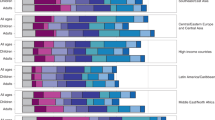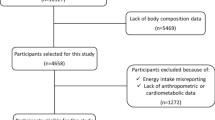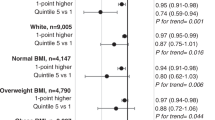Abstract
Background
From the 1960s to the early 21st-century adherence to the Mediterranean diet (MD) declined around the world. This was partly due to the westernization of eating habits. However, in the last decade a new variable came into play, the economic crisis, which may have affected dietary patterns.
Objective
We analyzed worldwide trends of adherence to the MD between the periods 1961–1965, 2000–2003 and 2004–2011.
Methods
Data was obtained from the Food and Agriculture Organization Food Balance Sheets in three study periods: 1961–1965, 2000–2003 and 2004–2011. The Mediterranean Adequacy Index (MAI) was calculated for 41 selected countries using the averages of available energy intake for different food groups. Changes in MAI indicated the trends in adherence in the different periods.
Results
In many countries, MAI deteriorated from 1961 to 1965 and 2004 to 2011, yet an increase was observed in 16 countries. Between the last two observation periods, MAI values stabilized in 16 of the 41 selected countries. Regional rankings for the three study periods based on descending MAI scores were: Southern Mediterranean, Mediterranean Europe, Central Europe and Northern Europe.
Discussion and Conclusions
Adherence to the MD significantly decreased between 1961–65 and 2000–03, whereas from 2004–2011 there was a stabilization of MAI values and even an increase among 16 countries. Efforts are needed to preserve the dietary traditions and lifestyle habits within the Mediterranean region in order to counteract increasing rates of chronic disease.
This is a preview of subscription content, access via your institution
Access options
Subscribe to this journal
Receive 12 print issues and online access
$259.00 per year
only $21.58 per issue
Buy this article
- Purchase on Springer Link
- Instant access to full article PDF
Prices may be subject to local taxes which are calculated during checkout

Similar content being viewed by others
References
Noah A, Truswell AS. There are many Mediterranean diets. Asia Pac J Clin Nutr. 2001;10:2–9.
Karamanos B, Thanopoulou A, Angelico F, Assaad-Khalil S, Barbato A, Del Ben M, et al. Nutritional habits in the Mediterranean Basin. The macronutrient composition of diet and its relation with the traditional Mediterranean diet. Multi-centre study of the Mediterranean Group for the Study of Diabetes (MGSD). Eur J Clin Nutr. 2002;56:983–91.
Willett WC, Sacks F, Trichopoulou A, Drescher G, Ferro-Luzzi A, Helsing E, et al. Mediterranean diet pyramid: a cultural model for healthy eating. Am J Clin Nutr. 1995;61(6 Suppl):1402S.
Serra-Majem L, Trichopoulou A, de la Cruz JN, Cervera P, Álvarez AG, La Vecchia C, et al. Does the definition of the Mediterranean diet need to be updated? Public Health Nutr. 2004;7:927–9.
Bach-Faig A, Berry EM, Lairon D, Reguant J, Trichopoulou A, Dernini S, et al. Mediterranean diet pyramid today. Science and cultural updates. Public Health Nutr. 2011;14:2274–84.
Bonaccio M, Di Castelnuovo A, Bonanni A, Costanzo S, De Lucia F, Persichillo M, et al. Decline of the Mediterranean diet at a time of economic crisis. Results from the Moli-sani study. Nutr Metab Cardiovasc Dis. 2014;24:853.
Antentas JM, Vivas E. Impacto de la crisis en el derecho a una alimentación sana y saludable. Informe SESPAS 2014. Gac Sanit. 2014;28:58–61.
Rao M, Afshin A, Singh G, Mozaffarian D. Do healthier foods and diet patterns cost more than less healthy options? A systematic review and meta-analysis. BMJ Open. 2013;3:e004277.
Lopez CN, Martinez-Gonzalez MA, Sanchez-Villegas A, Alonso A, Pimenta AM, Bes-Rastrollo M. Costs of Mediterranean and western dietary patterns in a Spanish cohort and their relationship with prospective weight change. J Epidemiol Com Health. 2009;63:920.
Darmon N, Drewnowski A. Contribution of food prices and diet cost to socioeconomic disparities in diet quality and health: a systematic review and analysis. Nutr Rev. 2015;73:643–60.
Keys A Seven countries. A multivariate analysis of death and coronary heart disease. Harvard University Press; 1980.
Serra-Majem L, Roman B, Estruch R. Scientific evidence of interventions using the Mediterranean diet: a systematic review. Nutr Rev. 2006;64(suppl 1):S27–S47.
Dinu M, Pagliai G, Casini A, Sofi F. Mediterranean diet and multiple health outcomes: an umbrella review of meta-analyses of observational studies and randomised trials. Eur J Clin Nutr. 2018;72:30–43. https://doi.org/10.1038/ejcn.2017.58
Sofi F, Macchi C, Abbate R, Gensini GF, Casini A. Mediterranean diet and health. Biofactors. 2013;39:335–42.
Bach A, Serra-Majem L, Carrasco JL, Roman B, Ngo J, Bertomeu I, et al. The use of indexes evaluating the adherence to the Mediterranean diet in epidemiological studies: a review. Public Health Nutr. 2006;9:132–46.
Bach-Faig A, Fuentes-Bol C, Ramos D, Carrasco JL, Roman B, Bertomeu IF, et al. The Mediterranean diet in Spain: adherence trends during the past two decades using the Mediterranean Adequacy Index. Public Health Nutr. 2011;14:622–8.
Balanza R, García-Lorda P, Pérez-Rodrigo C, Aranceta J, Bonet MB, Salas-Salvadó J. Trends in food availability determined by the Food and Agriculture Organization’s food balance sheets in Mediterranean Europe in comparison with other European areas. Public Health Nutr. 2007;10:168–76.
Fidanza F, Alberti A, Lanti M, Menotti A. Mediterranean Adequacy Index: correlation with 25-year mortality from coronary heart disease in the Seven Countries Study. Nutr Metab Cardiovasc Dis. 2004;14:254–8.
Rodrigues SSP, Caraher M, Trichopoulou A, de Almeida MDV. Portuguese households’ diet quality (adherence to Mediterranean food pattern and compliance with WHO population dietary goals): trends, regional disparities and socioeconomic determinants. Eur J Clin Nutr. 2008;62:1263–72.
da Silva R, Bach-Faig A, Raidó Quintana B, Buckland G, Vaz de Almeida MD, Serra-Majem L. Worldwide variation of adherence to the Mediterranean diet, in 1961–1965 and 2000–2003. Public Health Nutr. 2009;12:1676–84.
FAOSTAT (2017) Food Balance Sheets. Food and Agriculture Organization of the United Nations Statistics Division. http://faostat3.fao.org/home/E. Accessed March 2017.
Jacobs K, Sumner DA. The Food Balance Sheets of the Food and Agriculture Organization: A Review of Potential Ways to Broaden the Appropriate Uses of the Data. A review sponsored by FAO. Davis, California: University of California, Davis; 2002.
Alberti-Fidanza A, Fidanza F, Chiuchiù MP, Verducci G, Fruttini D. Dietary studies on two rural italian population groups of the Seven Countries Study. 3. Trend Of food and nutrient intake from 1960 to 1991. Eur J Clin Nutr. 1999;53:854–60.
Alberti A, Fruttini D, Fidanza F. The Mediterranean Adequacy Index: Further confirming results of validity. Nutr Metab Cardiovas Dis. 2009;19:61–66.
Alberti-Fidanza A, Fidanza F. Mediterranean Adequacy Index of Italian diets. Public Health Nutr. 2004;7:937–41.
Garcia-Closas R, Berenguer A, González CA. Changes in food supply in Mediterranean countries from 1961 to 2001. Public Health Nutr. 2006;9:53–60.
Zeghichi-Hamri S, Kallithraka S. Mediterranean diet in the Maghreb: An update. World Rev Nutr Diet. 2007;97:139.
Vareiro D, Bach-Faig A, Quintana BR, Bertomeu I, Buckland G, de Almeida MD, et al. Availability of Mediterranean and non-Mediterranean foods during the last four decades: comparison of several geographical areas. Public Health Nutr. 2009;12:1667–75.
Schmidhuber J, Traill WB. The changing structure of diets in the European Union in relation to healthy eating guidelines. Public Health Nutr. 2006;9:584–95.
Helsing E. Traditional diets and disease patterns of the Mediterranean, circa 1960. Am J Clin Nutr. 1995;61(6 Suppl):1329S.
Chen Q, Marques-Vidal P. Trends in food availability in Portugal in1966–2003: Comparison with other Mediterranean countries. Eur J Nutr. 2007;46:418–27.
Bacaria J, Folch R, París A, Renaga L, Ulied A, Vinas O, et al. Environmental atlas of the Mediterranean. The structure of the territory and the landscape. Fundació Territori i Paisatge, Barcelona 1999.
Tokudome S, Nagaya T, Okuyama H, Tokudome Y, Imaeda N, Kitagawa I, et al. Japanese versus Mediterranean diets and cancer. Asian Pac J Cancer Prev. 2000;1:61–66.
Serra-Majem L. Japomediterranean diet? Eur J Clin Nutr. 2004;58:1324–5.
Tokudome S, Ichikawa Y, Okuyama H, Tokudome Y, Goto C, Imaeda N, et al. The Mediterranean vs the Japanese diet. Eur J Clin Nutr. 2004;58:1323.
Bonaccio M, Bes-Rastrollo M, de Gaetano G, Iacoviello L. Challenges to the Mediterranean diet at a time of economic crisis. Nutr Metab Cardiovasc Dis. 2016;S0939–4753:30112–0.
Grosso G, Marventano S, Giorgianni G, Raciti T, Galvano F, Mistretta A. Mediterranean diet adherence rates in Sicily, southern Italy. Public Health Nutr. 2014;17:2001–9.
Thompson B. Impact of the financial and economic crisis on nutrition. Policy and programme responses. Consumer and protection división. FAO Rome, 2009.
Bach-Faig A, Geleva D, Carrasco J, Ribas-Barba L, Serra-Majem L. Evaluating associations between Mediterranean diet adherence indexes and biomarkers of diet and disease. Public Health Nutr. 2006;9:1110–7.
Lasheras C, Fernandez S, Patterson AM. Mediterranean diet and age with respect to overall survival in institutionalized, nonsmoking elderly people. Am J Clin Nutr. 2000;71:987–92.
Rodrigues S, Lopes C, Naska A, Trichopoulou A, De Almeida M. Comparison of national food supply, household food availability and individual food consumption data in Portugal. J Public Health. 2007;15:447–55.
Serra-Majem L, MacLean D, Ribas L, Brule D, Sekula W, Prattala R, et al. Comparative analysis of nutrition data from national, household, and individual levels: results from a WHO-CINDI collaborative project in Canada, Finland, Poland, and Spain. J Epidemiol Com Health. 2003;57:74–80.
Hu FB, Rimm EB, Stampfer MJ, Ascherio A, Spiegelman D, Willett WC. Prospective study of major dietary patterns and risk of coronary heart disease in men. Am J Clin Nutr. 2000;72:912–21.
Popkin BM, Gordon-Larsen P. The nutrition transition: worldwide obesity dynamics and their determinants. Int J Obes. 2004;28:S2–S9.
Lachat C, Van Camp J, De Henauw S, Matthys C, Larondelle Y, Winter AR, et al. A concise overview of national nutrition action plans in the European Union Member States. Public Health Nutr. 2005;8:266–74.
Trichopoulou A. Traditional Mediterranean diet and longevity in the elderly: a review. Public Health Nutr. 2004;7:943–7.
Dernini S. Towards the advancement of the Mediterranean food cultures. Public Health Nutr. 2006;9:103–4.
Funding
The present project was conducted for the Paralelo 40-World Mediterranean Diet Surveillance System. This article is published as part of a supplement sponsored by the Mediterranean Diet Foundation and the Diputació de Barcelona.
Author information
Authors and Affiliations
Corresponding author
Ethics declarations
Conflict of interest
RE has received lecture fees from Brewers of Europe, Belgium, Cerveceros de España, Spain, Fundación Dieta Mediterránea, Instituto Cervantes, Madrid, Interprofesional del Aceite de, Oliva, Madrid, Spain, Lilly Laboratories SA, Spain. RE has also received grant support from Consorcio Centro de Investigación Biomédica en Red (CIBER) Obesidad, Health Research Project grant from the Carlos III Institute of Health, Ministry of Economy and Competitiveness of Spain (FIS), La Marató Foundation of TV3, Grand Fontaine, SA, National Institute on Alcohol Abuse and Alcoholism (NIAAA), USA. None of the other authors report any conflicts of interest.
Rights and permissions
About this article
Cite this article
Vilarnau, C., Stracker, D.M., Funtikov, A. et al. Worldwide adherence to Mediterranean Diet between 1960 and 2011. Eur J Clin Nutr 72 (Suppl 1), 83–91 (2019). https://doi.org/10.1038/s41430-018-0313-9
Published:
Issue Date:
DOI: https://doi.org/10.1038/s41430-018-0313-9
This article is cited by
-
Adherence to the Mediterranean diet and 20-year incidence of hypertension: the ATTICA prospective epidemiological study (2002–2022)
European Journal of Clinical Nutrition (2024)
-
The modulation of sustainability knowledge and impulsivity traits on the consumption of foods of animal and plant origin in Italy and Turkey
Scientific Reports (2022)
-
Adherence to Mediterranean diet in athletes: a narrative review
Sport Sciences for Health (2022)
-
Foods with microalgae and seaweeds fostering consumers health: a review on scientific and market innovations
Journal of Applied Phycology (2020)



